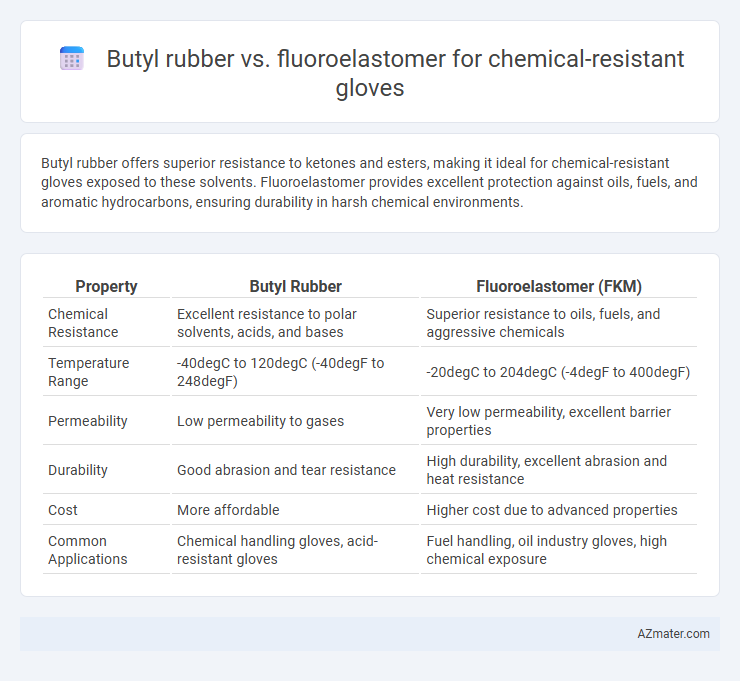Butyl rubber offers superior resistance to ketones and esters, making it ideal for chemical-resistant gloves exposed to these solvents. Fluoroelastomer provides excellent protection against oils, fuels, and aromatic hydrocarbons, ensuring durability in harsh chemical environments.
Table of Comparison
| Property | Butyl Rubber | Fluoroelastomer (FKM) |
|---|---|---|
| Chemical Resistance | Excellent resistance to polar solvents, acids, and bases | Superior resistance to oils, fuels, and aggressive chemicals |
| Temperature Range | -40degC to 120degC (-40degF to 248degF) | -20degC to 204degC (-4degF to 400degF) |
| Permeability | Low permeability to gases | Very low permeability, excellent barrier properties |
| Durability | Good abrasion and tear resistance | High durability, excellent abrasion and heat resistance |
| Cost | More affordable | Higher cost due to advanced properties |
| Common Applications | Chemical handling gloves, acid-resistant gloves | Fuel handling, oil industry gloves, high chemical exposure |
Introduction to Chemical-Resistant Glove Materials
Chemical-resistant gloves are essential for protecting hands from hazardous substances in various industries. Butyl rubber offers excellent resistance to gases, ketones, and esters, making it ideal for handling chemicals like acids and oxidizers. Fluoroelastomer gloves provide superior resistance to a broader range of chemicals, especially hydrocarbons, oils, and solvents, ensuring high durability and chemical stability in aggressive environments.
Overview of Butyl Rubber Gloves
Butyl rubber gloves provide exceptional resistance to gases, ketones, and esters, making them ideal for handling a variety of chemicals in industrial settings. Their excellent impermeability and flexibility ensure prolonged protection against toxic substances, while maintaining comfort during extended use. Butyl rubber gloves outperform many other materials in chemical permeation resistance, especially against slow-penetrating chemicals and hazardous vapors.
Overview of Fluoroelastomer (FKM) Gloves
Fluoroelastomer (FKM) gloves provide exceptional chemical resistance, particularly against oils, fuels, and aggressive solvents, surpassing the performance of butyl rubber in harsh industrial environments. These gloves maintain flexibility and durability at high temperatures up to 200degC, making them suitable for diverse applications requiring long-lasting protection. Fluoroelastomer compounds exhibit superior resistance to swelling, degradation, and permeation, ensuring enhanced safety in chemical handling and processing tasks.
Chemical Resistance Comparison
Butyl rubber exhibits excellent resistance to polar solvents, acids, and alkalis, making it highly effective against chemicals like ketones and esters commonly encountered in industrial applications. Fluoroelastomer outperforms butyl rubber in resisting a wider range of aggressive chemicals, including hydrocarbons, oils, and solvents, thanks to its strong carbon-fluorine bonds that provide superior chemical stability. For gloves requiring high protection against aggressive solvents and petroleum-based chemicals, fluoroelastomer offers enhanced durability and resistance compared to butyl rubber.
Durability and Mechanical Properties
Butyl rubber exhibits excellent chemical resistance and superior impermeability to gases, making it highly durable in harsh chemical environments, while offering good tensile strength and elongation for flexibility. Fluoroelastomers provide exceptional resistance to a broader range of aggressive chemicals, including oils and solvents, with enhanced mechanical properties such as high tensile strength, abrasion resistance, and resistance to heat aging. For chemical-resistant gloves, fluoroelastomers generally outperform butyl rubber in durability under extreme conditions, yet butyl rubber maintains strong mechanical performance in flexible and puncture-resistant applications.
Comfort and Flexibility
Butyl rubber excels in flexibility and offers exceptional comfort for chemical-resistant gloves, allowing extended wear without causing hand fatigue. Fluoroelastomer gloves, while highly resistant to a broad spectrum of chemicals, often have a stiffer texture that can limit dexterity and reduce comfort during prolonged use. Selecting gloves depends on prioritizing either superior chemical resistance with fluoroelastomers or enhanced flexibility and comfort with butyl rubber.
Temperature and Environmental Performance
Butyl rubber offers excellent chemical resistance and retains flexibility in temperatures ranging from -40degC to 120degC, making it ideal for environments with moderate temperature variations. Fluoroelastomers outperform butyl rubber under extreme conditions, maintaining structural integrity and chemical resistance from -20degC up to 200degC, suitable for high-heat applications and aggressive chemical exposure. Environmental performance favors fluoroelastomers due to superior resistance against ozone, UV radiation, and hydrocarbon solvents, ensuring longer glove durability in harsh industrial settings.
Cost and Availability
Butyl rubber gloves offer a cost-effective solution with moderate chemical resistance and widespread availability, making them suitable for general chemical handling. Fluoroelastomer gloves provide superior chemical resistance, especially against solvents and aggressive chemicals, but come at a higher price point and limited availability due to specialized manufacturing. Choosing between the two depends on budget constraints and the specific chemical exposure risks in the work environment.
Typical Applications and Industries
Butyl rubber gloves excel in handling ketones, esters, and oxidizing chemicals, making them ideal for pharmaceutical manufacturing, chemical processing, and emergency response industries. Fluoroelastomer gloves offer superior resistance to oils, fuels, and aggressive solvents, commonly used in aerospace, automotive, and petrochemical sectors. Both materials protect workers from hazardous substances, but selection depends on specific chemical exposure and industry regulations.
Choosing the Right Glove Material
Choosing the right glove material for chemical resistance hinges on the specific chemicals and exposure duration; butyl rubber excels in resisting ketones, esters, and oxidizing chemicals while offering superior impermeability to gases. Fluoroelastomer gloves provide exceptional protection against a broad range of oils, fuels, and solvents, maintaining durability in high-temperature environments. Understanding the chemical composition and working conditions is crucial for selecting between butyl rubber and fluoroelastomer to ensure optimal safety and performance.

Infographic: Butyl rubber vs Fluoroelastomer for Chemical-resistant glove
 azmater.com
azmater.com